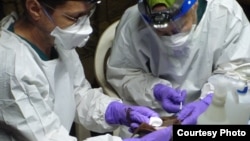Ebola is an ancient virus that evolved over thousands of years in the Congo Basin. It occurs naturally among a number of different species in the wild.
From time to time, humans come in contact with animals that harbor Ebola, setting into motion an animal-to-human transmission chain that causes an epidemic.
The U.S.-based Wildlife Conservation Society wants to know more about which animals harbor the virus so efforts can be made to halt the encroachments of Ebola into the human population.
One of the group’s latest efforts has taken scientists into the jungles of the Nouabale-Ndoki Park in the Republic of Congo, to study Red River pigs as a possible vector or source of the virus.
Other well-known Ebola vectors include infected fruit bats and apes, including gorillas.
Steve Osofsky, a veterinarian and director of wildlife health and health policy for the conservation group, said researchers have developed a way to look for evidence of Ebola in animal dung.
“We can walk through the forest, collect recognizable chimp and gorilla poop, if you will, and test it for Ebola," he said. "And we’re finding in places where Ebola has spread, there are survivors who are now healthy and normal and have evidence of exposure through these antibodies we’ve been able to detect in the feces. And that tells us which populations have been exposed.”
Then, Osofsky added, people living near those populations can take steps to protect themselves from Ebola.
A study on the dung antibodies was published recently in the journal PLoS Neglected Tropical Diseases.
Osofsky said his organization was also interested in identifying reservoirs of disease, including how the virus potentially circulates among different species, such as bats, pigs and nonhuman primates.
Researchers have set up remote cameras near fruit trees to monitor animal activity. Osofsky said scientists are interested in the interplay among animals eating the fruit that may be contaminated by bats, or coming in contact with their dung, saliva or urine.
They hope to discourage human behavior that might spread Ebola to nearby villages.
“When these animals die, we now know that’s an early warning that Ebola is present," he said. "And by curtailing that behavior, we know that we haven’t seen outbreaks of Ebola in those villages that have taken this message to heart.”
The conservation group warns local residents not to collect animal carcasses for food.
Conservationists are also trying to discourage logging companies from hunting animals that could harbor the virus, as well as trying to protect animals from poachers who disturb wildlife areas where Ebola reservoirs exist.











